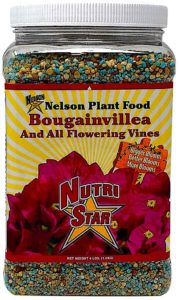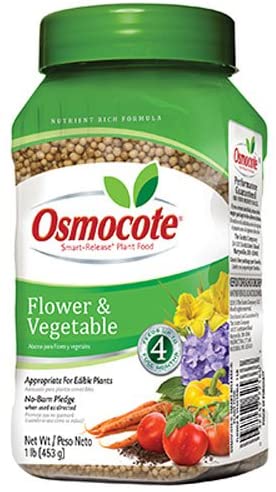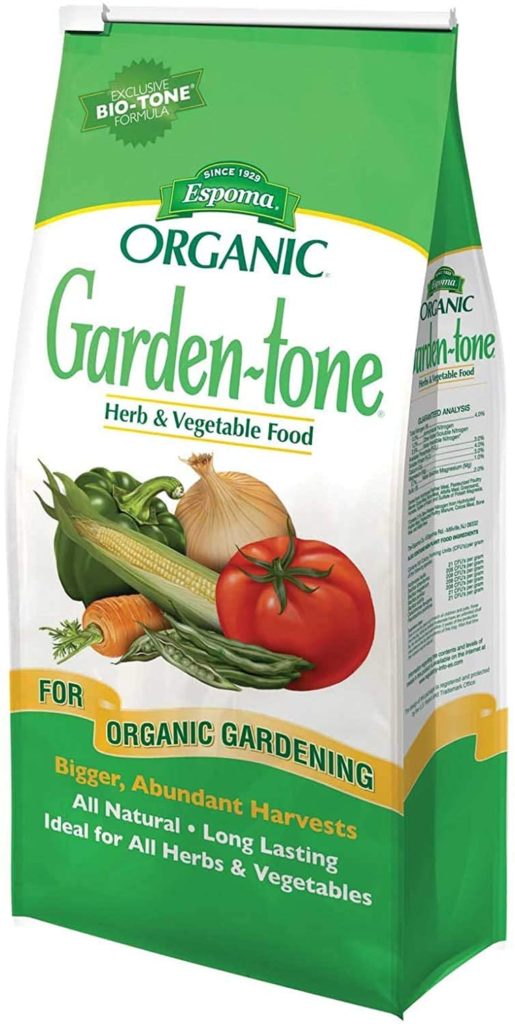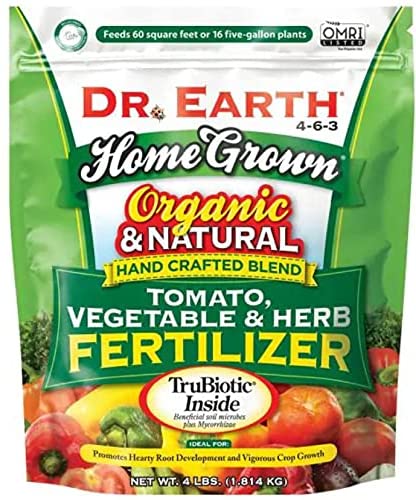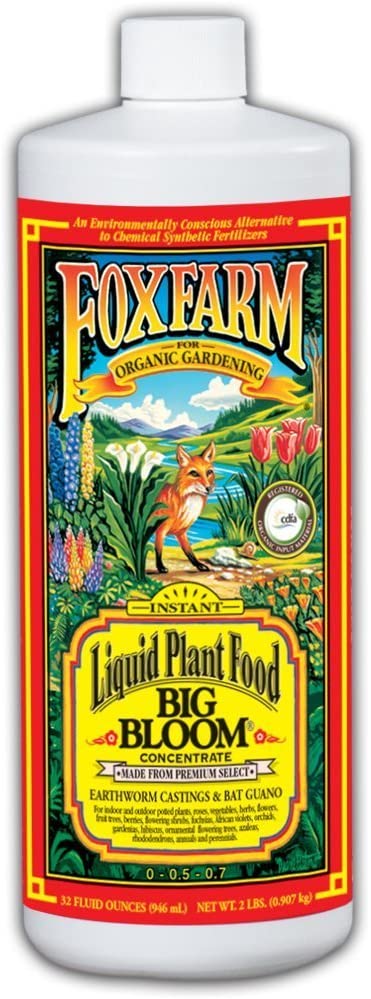One of the most well-known members of the mint family, Rosemary is well-known for its culinary and medicinal applications. In addition to being drought and deer resistant, Rosemary requires little in terms of water, fertilizer, or maintenance to grow.
To get the best results from Rosemary, the fertilizer should have more nitrogen than phosphorus and potassium, contain acidifying agents like sulfur, as well as give rapid and controlled-release feeding of macro-and micronutrients.
Top 5 Best Fertilizers For Rosemary
Rosemary requires significantly less fertilizer, care, and water when compared to other hungry plants, owing to its drought resistance and total deer resistance. Therefore, if you plan to grow Rosemary in pots, slow-release fertilizers in tablet, granular, or pellet form are ideal.
Liquid fertilizers may be a good option if you plan to grow Rosemary as a shrub because they are easier to give than solid fertilizers. Fertilizers containing a high concentration of iron are suitable for plants with dark green leaves. An NPK fertilizer with a high phosphorus ratio is ideal for indoor rosemary production because strong roots are essential for the plant to grow successfully. Listed below are the top five best fertilizers for Rosemary.
1. Jobe’s Organics 0 Slow Release Fertilizer
Organics 09686 is one of the best rosemary plant fertilizers. The slow-release nature of this fertilizer guarantees that your rosemary plants receive an adequate supply of nutrients, regardless of whether they are annuals or perennials. In addition, the presence of a high phosphorus concentration in this fertilizer aids in the formation of strong root systems.
Because it is available in granular form, rosemary plants select it as their preferred slow-release fertilizer because it is easy to apply. For maximum nutrient release, the granules have been meticulously wrapped with a high-quality organic layer to ensure that the fertilizer’s nutrient content is only released when required by your rosemary plant.
Rosemary is an acid-loving plant. The high nitrogen concentration in these fertilizers encourages lush, vegetative growth and development. Because of the soil’s low potassium and phosphorus levels, rosemary plants can grow more quickly and efficiently. Since rosemary blood food is free of any inorganic chemicals, consumers can enjoy a fresh, clean aroma due to the absence of inorganic chemicals in the meal. Because the raw material is organic, it is completely safe for both pets and humans.
Features:
- Natural and eco-friendly
- Non-toxic, non-flammable, OMRI-certified organic gardening
- Safe for both the environment and a plant’s nutritional needs
Pros and Cons:
- 100% organic fertilizer
- Application is simple
- Nitrogen levels are extremely high
- Burning impact is reduced
- Reduced potassium concentrations
2. Osmocote 277160 Smart-Release Plant Food
Trying to come up with a long-term solution for promoting the growth of your rosemary plants. Your rosemary garden and Osmocote Plant Food are a wonderful fit. The granular form of this Smart-Release Osmocote fertilizer ensures that your rosemary plants receive a complete and suitable nutrient supply for up to four months after it is applied to the ground.
Strong root development helps to increase the size of the leaves and the plant size of Rosemary. In addition, the high potassium concentration will enhance the flavor of the mint as well as the pine-like aroma. Because of the NPK ratio of nitrogen to phosphorus in this fertilizer, perennial plants may be able to handle it.
Extremely high nitrogen levels encourage aggressive tip and top growth, which in turn facilitates the rapid expansion of new branches. Using the NPK ratio of 20(N)-20(P)-20(K), Rosemary’s plant food is a good choice. It is intended for this Osmocote fertilizer to be absorbed directly by the plant, making the application as simple as possible.
When spraying Osmocote fertilizer around the base of the rosemary plant, use one scoop of Osmocote fertilizer for every 4 square feet or one scoop for every 2 liters of water. Always remember that three tablespoons (or one scoop) of Osmocote fertilizer is the same as one scoop of organic fertilizer.
Features:
- Boosts top growth and root development
- Vegetable gardeners need this!
- Preferable for annual crops and perennials
- Designed to produce succulent, delicious vegetables and vibrant blossoms
- Feeds up to four months.
Pros and Cons:
- Product made from natural ingredients
- The product is non-staining
- 4 months of food
- The product must be applied thoroughly
Also Read: Best Fertilizer for Bougainvillea in 2022 – A Complete Buying Guide
3. Espoma Garden-Tone Fertilizer
The fertilizer is a blend of seven natural ingredients, including feather meal, bone meal, poultry manure, alfalfa meal, greensand, sulfate of potash, and sulfate of potash magnesia. Other ingredients include sulfate of potash and sulfate of potash magnesia. The product label contains 3 percent nitrogen, 4 percent phosphorus, 4 percent potassium, 5 percent calcium, 1 percent magnesium, and 2 percent sulfur.
The fertilizer provides both NH4+ and NO3- from two different sources, allowing Rosemary to absorb the maximum nitrogen possible. Additionally, it contains 2.2 percent slow-release Nitrogen, which will ensure that the plant is well taken care of during the growing season. Finally, it contains 0.3 percent slow-release magnesium to ensure that chlorophyll production is not interrupted for up to four weeks after it is applied.
Among the many unique characteristics of this fertilizer is its exclusive BioTone formulation. The combination comprises more than 600,000 colonies of beneficial soil microbes. Due to the use of this particular blend, organic matter is broken down, and the soil becomes well-drained and nutrient-rich.
Furthermore, the fertilizer incorporates 1 percent humic acid into the soil, which helps to improve soil fertility, nutrient uptake, drought tolerance, and a variety of other benefits for plants. 1.5 tablespoons of the granules should be used to coat the inside of an 8-inch-diameter pot. Make sure to water it properly.
Features:
- Bio-tone formula: 3-4-4 Fertilizer analysis with 5% calcium
- pH level: 5.5-7.5
Pros and Cons:
- No GMOs
- 100% organic
- Garden-tone is environmentally safe
- Reasonably priced.
- Fertilizer overdosing causes molding
4. Dr. Earth Organic Tomato Vegetable & Herb Fertilizer
This product contains what is probably the best organic fertilizer for Rosemary on the market. There is a slew of factors that contribute to this situation. First, this product is made by Dr. Earth, a well-known global company that is known for producing cutting-edge, thoroughly researched products. Because it is a handcrafted blend of natural elements such as fishbone, bone, feather, alfalfa, kelp flour, and other substances, the fertilizer has been authorized for organic use by the Organic Materials Review Institute (OMRI).
Furthermore, these sources give 4 percent nitrogen, 6 percent phosphorus, 3 percent potassium, and 7.5 percent calcium. The attention is immediately drawn to the higher phosphorus level compared to nitrogen and potassium than in other foods. Because Rosemary is a flowering plant, it’s important to remember that it’s also used as a culinary flavoring. This, however, is not the only possible answer.
To your astonishment, this fertilizer’s full 4 percent nitrogen content is water-insoluble, allowing for a progressive release of nitrogen over time. As a result, Rosemary receives instant P, while the fertilizer continues to provide N throughout the season. In addition, TruBiotic is a fertilizer that contains a blend of healthy soil bacteria and Mycorrhizae, both of which are good for plants. As a result of the abundant water and nutrients this soil provides, Rosemary thrives.
The humic acid level is 6 percent, which boosts coil microbial activity while promoting root growth and development. 4 tablespoons of granulated fertilizer should be sprayed into the potting soil. Before watering it completely, rake up some dirt around the area. After two months, a second spray is required during the growing season.
Features:
- Plant nutrition at optimal levels.
- No GMOs, poultry dung, or sewage sludge
- Lasts several months
- 100% organic and natural components
- Probiotic, seven champion soil microbial strains, and ecto and endo mycorrhizae
pros and Cons:
- Designed to feed tomatoes, veggies, and herbs
- This product contains TruBiotic soil microorganisms and mycorrhizae
- No synthetic chemicals or GMO-contaminated chicken manure
- Incorrect fertilizer dosage may be harmful
5. Root Supplement Fertilizer For Rosemary Bush
Consider applying a root supplement and protector to your rosemary bush to ensure that it has a robust root system. If your plant has well-developed root systems, it will be able to draw water and nutrients from the soil after fertilizer application. Even when temperatures drop to dangerously low levels during the winter months, whether Rosemary is grown indoors or outdoors, the roots will remain free of root rot due to the presence of this root protectant.
It is important to note that phosphorus is an important component of this fertilizer because it assists in the growth of strong roots in rosemary shrubs. Therefore, it is necessary to place the root supplement, and protector in your watering can and top it out with fresh water. Consider soaking both the roots and the foliage in order to achieve the most beneficial outcomes possible.
The potassium found in the rosemary bush and enhancing the dark green tint of the plant are responsible for this. Because of its piney aroma, the rosemary bush is a great addition to any garden. Maintaining the health of the plant’s root system, which is its major purpose, is an important part of rosemary plant care indoors.
Features:
- Instant plant food boosts fruit and vegetable flavor and smell
- Quick and easy way to feed young trees, shrubs, and container plants
- Nutrients for up to 2 years of plant feeding
Pros and Cons:
- 100% Organic product
- Application is simple
- Pet-friendly
- Liquid in nature
FAQ’s
Consider fertilizing your rosemary in the spring if you want to ensure that it gets off to a good start in the season. In order to provide your plants with a moderate amount of nitrogen, consider utilizing a high-quality all-purpose fertilizer. Because of the quick development that happens later in the year as a result of the high nitrogen concentration in the spring, it is possible to obtain lush vegetation as a result of the high nitrogen concentration in the spring. The use of an iron-rich fertilizer during the summer or even in the late spring may help to enhance the minty aroma of the Rosemary plant.
Rosemary requires less fertilizer and feed than other hungry plants since it is drought tolerant and deer resistant. As a result, it requires less water and other resources. If you’re growing rosemary in a container, slow-release fertilizers in tablet, granule, or pellet form are the best option. If you plan to grow rosemary as a shrub, liquid fertilizers may be a good option because they are easier to give than solid fertilizers. The use of iron-rich fertilizers such as these is great for the production of dark green foliage. If you want to grow rosemary indoors, the ideal fertilizer to use is one with a high phosphorus to nitrogen ratio in an NPK fertilizer.
There are a variety of methods for relishing rosemary’s pine-like perfume and strong flavor, including treating the plant, trimming it back, transplanting it to a larger pot, and applying the most appropriate NPK fertilizers for rosemary in a 20(N)-20(P)-20 ratio (K). Identify a fertilizer supplier that incorporates a high concentration of iron if the leaves on your rosemary plant are turning yellow. The high potassium content in the NPK fertilizer ratio of 20(N)-20(P)-20(K) will help to boost the pine-like aroma of rosemary plants. A phosphorus-rich fertilizer should be applied to rosemary plants that are showing indications of wilting.
Conclusion
Consider fertilizing your Rosemary in the spring to ensure that it gets off to a good start in the season. Consider using a decent all-purpose fertilizer with a somewhat high nitrogen concentration as a beginning point for your garden. Because rosemary plants are shrubs, you must take care not to disturb the roots of your rosemary plant when planting it.
As an alternative to mechanical tilling, consider using this rosemary soil aerator fertilizer, which is as efficient as mechanical tilling. Pick carefully, and your garden and food will become more attractive and delicious as a result of your decision.

